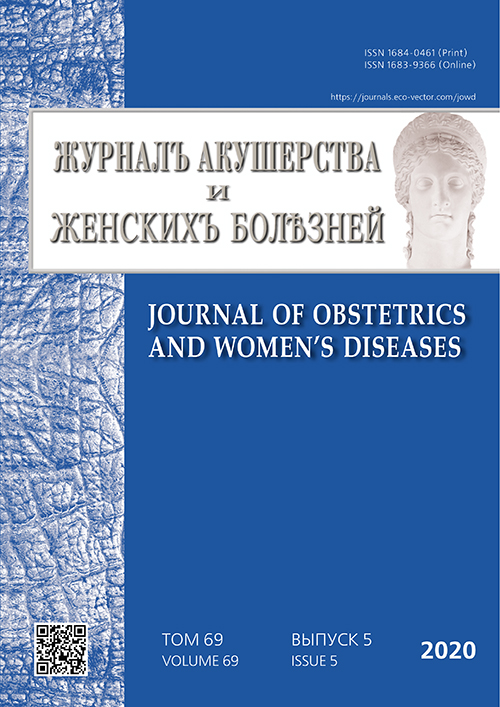腹腔会阴手术矫正结肠癌病历中的生殖道脱垂的经验
- 作者: Plekhanov A.N.1,2,3, Bezhenar V.F.1, Karachun A.M.4, Bezhenar F.V.2, Tsypurdeyeva A.A.5,6, Epifanova T.A.1,2
-
隶属关系:
- Academician I.P. Pavlov First Saint Petersburg State Medical University
- Saint Petersburg Clinical Hospital of the Russian Academy of Sciences
- Academy of Medical Education named after F.I. Inozemtsev
- N .N. Petrov National Medical Research Center of Oncology
- Saint Petersburg State University
- Research Institute of Obstetrics, Gynecology, and Reproductology named after D.O. Ott
- 期: 卷 69, 编号 5 (2020)
- 页面: 87-97
- 栏目: Original study articles
- ##submission.dateSubmitted##: 23.12.2020
- ##submission.dateAccepted##: 23.12.2020
- ##submission.datePublished##: 23.12.2020
- URL: https://journals.eco-vector.com/jowd/article/view/56614
- DOI: https://doi.org/10.17816/JOWD69587-97
- ID: 56614
如何引用文章
详细
最近的一些研究表明,与标准的腹会阴联合切除术相比,肛提肌外腹会阴联合切除术能提高远端直肠癌的肿瘤学效果。作为肛提肌的切开的结果,会阴形成广泛的缺陷,这需要阴道会阴成形术。在进行肛提肌外腹会阴联合切除术的过程中,形成盆腔隔膜受到影响,因此,经过这种干预,女性有较高的盆腔器官脱垂的风险。这严重影响了生活质量,并导致后续手术治疗的需要。尽管盆腔器官脱垂是手术治疗的结果,肿瘤学家并不认为它是术后长期的并发症。这样的病人不转诊给手术妇科医生。目前对这一问题了解甚少,因此这类患者的盆腔器官脱垂手术治疗尚无标准化的方法。
全文:
绪论
直肠癌在恶性肿瘤中占发病率和死亡率的首位。2017年,俄罗斯新增
29918例直肠癌病例,16360患者死于这种
原因[1]。
根据NCCN的建议,对于直肠壶腹和肛管癌局部进展期癌症的标准手术治疗是腹会阴联合切除术(APR)[1, 2]。
考虑到手术技术的进步,结合治疗方法
(放化疗、辅助化疗),肿瘤医师能够取得越来越好的治疗效果,但也出现了新的问题:如果在经典APR之后的早期,
提取的制剂呈沙漏状,提取的组织体积相对较小,然后,当对MRI确认的肿瘤长入盆底肌肉的患者进行肛提肌外腹会阴联合切除术(ELAPE)时,骨盆内形成了明显的空腔,其增加炎症过程的风险[3, 4],
并形成会阴疝[5]。
ELAPE的方法在于这样一个事实:当进行会阴手术阶段时,从提肛肌向外进行
分离,与后者的交点位于骨盆骨的附着
位置(图1)。这种组织呈圆柱形,因此在文献中又有了另一个名字—圆柱形APR。
图 1。 在标准(a)和肛提肌外腹会阴联合切除术(b)的剥离线
接受ELAPE的适应症考虑为下腹部和中腹部直肠癌T3-T4。目前,ELAPE广泛应用于世界各大医院。一些研究人员建议所有APR病例都进行肛提肌的切开[6, 7]。
最近的一些研究表明,与标准的APR
相比,ELAPE能提高远端直肠癌的肿瘤学效果。然而,作为肛提肌的切开的结果,会阴形成广泛的缺陷,这需要阴道会阴成形术(图2)[8]。
图 2。 进行肛提肌外腹会阴联合切除术后的会阴部创面
尽管这个问题似乎长期存在,但APR
术后缺损的整形手术问题仍然是开放的。
许多技术被提出用于闭合ELAPE后形成的会阴缺损。这些包括简单的缝合会阴皮下组织及皮肤,骨盆底整形手术使用外科植入物,血管的肌皮瓣移植术或血管蒂肌瓣移植术。所有讨论的闭合盆底缺损的方法都有各自的优缺点。
最简单和最经济的选择是缝合会阴皮下组织及皮肤。根据文献,不满意这样的整形手术的结果与高水平的感染性并发症术后早期和长期(频率高达67%[9])频繁会阴疝的形成时期由于缝合皮肤之间的空腔形成的循环小肠[10]。
下一个选择闭合盆底缺损是使用合成或生物组织。从技术角度看,这种方法与用网状假体修复腹疝相同。然而,在周围组织受到辐射泄漏的情况下使用合成材料,有排斥移植物的风险。第二个严重的缺点是无法将移植物与游离腹腔分离,这反过来导致小骨盆出现大量粘连,并可能出现并发症(急性肠梗阻、出现肠道瘘的可能性)。在网状植入物中使用复合抗粘剂是有问题的,因为材料的结构和抗粘附凝胶固定不良[11]。
闭合盆底缺损的第三个选择是血管蒂肌瓣移植术。为此,最常使用臀大肌和腹直肌(VRAM—纵行腹直肌肌皮瓣)。
由于整形VRAM皮瓣的复杂性,该技术主要用于会阴大面积软组织缺损的修复。这些类型的整形手术显著增加了手术的创伤,这限制了它在虚弱和年龄相关患者中的
应用。并发症可同时发生在会阴和供血
部位[11]。
重建技术有很多选择,但很少有随机对照试验能够让结束这个问题;会阴创面缺损的修复问题一直没有得到解决。
这个问题对妇科医生来说同样重要。在进行ELAPE的过程中,形成盆腔隔膜的结构受到影响。因此,进行ELAPE后,
妇女盆腔器官脱垂的风险增加,这严重影响了生活质量,导致需要后续手术治疗。
虽然盆腔器官脱垂是先前手术治疗的结果,肿瘤学家并不认为这是术后长期的并发症。与此同时,这些患者在术后期间由肿瘤医生观察,但一般来说,
即使面临盆腔器官脱垂,她们也不找妇科医生咨询。然而,这个问题的发生机制是纯妇科的,并在术后的长期期间,这些患者应该转诊给手术妇科医生。本题目在现代医学文献中几乎没有涉及到,因此本研究的任务就是对上述问题进行研究,并为行ELAPE且面临盆腔器官脱垂问题的患者创造一种手术治疗算法。
材料与方法
本研究的目的是比较有ELAPE病史的盆腔器官脱垂患者不同类型手术治疗的即时结果。
自2019年以来,俄罗斯科学院的Saint Petersburg Central Clinical Hospital of the Russian Scientific Academy收治了多名患有这种病理的患者。考虑患者的年龄、是否有伴随疾病、维持性生活的任务等因素,选择不同的手术治疗策略。
作为这个问题研究的一部分,目前已经对三名患者进行了临床观察。
结果
临床观察1例
80岁的患者。
2016年确诊为pT3N1cM0G2直肠癌。
她认为自己病了一年,那时他抱怨大便不稳定,产生的气体增多,大便出现有血丝。
纤维结肠镜检查显示在肛门上方2厘米处有一个核状物,组织学证实为浸润性腺癌。
2016年6月行腹腔镜腹会阴联合切
除术。
2019年,患者抱怨会阴有异物感,
会阴疼痛(图3)。
图 3。 病人术前情况
在这种情况下,第一阶段的手术治疗需要子宫切除术,但考虑到患者的年龄、躯体病史、缺乏解剖标志以及术中对邻近器官损伤的高风险,决定拒绝手术治疗。检查时,阴道后壁处长了很多颗粒,因为上一次手术后骨盆骨膜以上软组织的数量很少,并这些组织缺乏血液供应。手术前3个月,患者接受组织再生刺激剂局部治疗,但处长的颗粒未完全愈合。在这方面,因为在这种情况下网状植入物侵蚀的风险很高,因此有必要避免其安装。术前行盆腔超声检查排除子宫内膜病变。综合以上因素,
为了矫正器官脱垂,选择了用自己的组织进行整形手术,然后根据我们改良的Le Faure手术进行阴道闭合术。
手术的过程。在这种情况下,与使用网状植入物在膀胱阴道的筋膜下安装假体的整形手术不同,进行筋膜剥离手术是不切实际的,因为这将导致疤痕区域的组织阵列变薄,以及术后缝合线的绽开。
切开筋膜上方的阴道粘膜就足够了,这将允许在术后期间形成一个更致密和更丰富的疤痕(图4)。
图 4。 膀胱切除术
剥离后,先用袋缝合线浸没膀胱,
再用U型线浸没膀胱(图5)。
图 5。 实用圆环的缝合线浸泡分离膀胱
下一步是膀胱阴道筋膜和ELAPE后残留的直肠阴道筋膜部分的缝合(图6—8)。
图 6。 膀胱阴道筋膜和直肠阴道筋膜的缝合
图 7。 手术结束后会阴示意图
图 8。 手术的最后阶段—皮肤缝合
由于手术的结果,达到了预期的临床效果(图9)。
图 9。 术后9个月
临床观察2例
55岁的患者。
2017年确诊为T2N0M0直肠癌。
2017年行腹腔镜下腹会阴联合切除术并形成乙状结肠的体积手术治疗。术后并发了皮下直肠周炎,外阴溃烂。然后形成了外阴阴道瘘。
2019年,患者抱怨会阴有异物感,
会阴疼痛(图10)。
图 10。 病人术前情况
在这个临床观察中,出现了与前一个病例相似的情况。阴道后壁有大量愈合不良的颗粒。术前行3个月局部雌激素
治疗,效果较弱。
选择了一个类似的手术策略,但考虑到没有体细胞病理,存在解剖标志,
在手术治疗的第一阶段进行子宫切除术,然后,用袋缝合线缝合腹腔后,采用与
第一次临床观察相似的技术进行阴道
闭合术。
在子宫切除术阶段,解剖结构显示
良好,宜使用电外科器械。在经阴道子宫切除术中使用电外科器械与传统结扎相比有许多不可否认的优点(与传统方法
相比,减少术后疼痛,减少术中出血量,缩短手术时间)[12]。
在这种情况下,使用了Bowa ARC 400电动手术器械,以及可重复使用的开腹手术的Bowa TissueSeal PLUS COMFORT夹子
(图11,12)。
图 11。 Bowa ARC 400电动手术器械和开腹手术的Bowa TissueSeal PLUS COMFORT夹子
图 12。 开腹手术的Bowa TissueSeal PLUS COMFORT 夹子在阴道子宫切除术中的应用
由于手术的结果,达到了预期的临床效果(图13)。
图 13。 术后第7天的手术区
临床观察3例
这种疾病多见于年轻妇女,其让外科医生恢复性生活的能力。
36岁的患者。
2015年确诊为T4N1M0/ypT4N0M0的肛
管癌。
2016年行2个周期的放化疗联合治疗。
后来,肿瘤进展,形成了直肠阴道瘘。
2017年9月行腹会阴联合切除术并阴道后壁切除术。采用VRAM皮瓣行阴道后壁切除术。
在初次咨询医生时,病人抱怨阴部有异物的感觉,性交时不适。在上述病
例中,观察到阴道后壁有大量颗粒,但在这个案例中,这并不会成为使用网状植入物进行整形手术的障碍,由于需要仅在保留阴道筋膜的阴道前壁区域对缺损(膀胱膨出)进行整形手术(图14)。
图 14。 病人术前情况
考虑到患者年龄比较小,渴望性生活,
无伴随的病理,决定了使用VYPRO网状植入物进行整形手术(图15-18)。
图 15。 膀胱切除术
图 16。 用于固定网状植入物,进行导丝和固定螺纹
图 17。 VYPRO网状植入物固定
图 18。 手术后伤口缝合
由于骶脊髓韧带和提上睑肌缺失,无法将植入物固定在骶脊髓韧带和提上睑肌上,
因此通过闭孔和骨盆骨膜进行固定(图16)。
在最后阶段,患者接受了阴道后壁修补术。由于颗粒的存在、高组织张力和提肌缺乏,以及手术缝合线绽开的高风险,
不可能在足够的体积下进行单期矫正
(图19)。
图 19。 阴道后壁整形手术
图 20。 手术的最后阶段—皮肤缝合
4个月后(图21),应患者要求,进行第二阶段手术治疗,即阴道后壁修补术,以增加阴道深度,减小阴道前庭的大小
(图22-25)。
图 21。 第一阶段手术治疗后四个月
图 22。 阴道后壁组织的解剖
图 23。 阴道后壁修补术
图 24。 手术的最后阶段—皮肤缝合
图 25。 第二阶段手术治疗后1个月
在这种情况下,阴道后壁修补术只由脂肪组织和皮肤进行(图23)。在这种情况下,整形手术的主要困难是由于提上睑肌的缺失和ELAPE区域颗粒的存在。
干预后一个月患者对手术效果感觉
满意。手术后外科医生继续观察患者。
讨论和结论
尽管对这类患者的手术治疗经验很少,
但我们已经可以得出结论,目前对这类患者的手术治疗策略的选择还没有统一的通用方法。在每种情况下,都需要根据各种因素,仔细选择手术治疗策略,如既往接受过手术、患者年龄、是否有伴随的躯体病变、是否有过性生活的愿望,此外,
还需要考虑网状植入物所引起的侵蚀性及其他并发症的风险。值得注意不使用网状植入物的治疗效果良好。这类患者是否需要行子宫切除术的问题值得关注。子宫切除术优选在所选择的方法是改良的
Le Faure手术的情况下进行,但如果患者因风险高而无法实施,如缺乏解剖
标志、邻近器官损伤、患者年龄以及伴随的躯体病理有关,手术治疗可以保存
子宫。今后,这样的病人应在妇科医生的动态监护下进行。
作者简介
Andrey Plekhanov
Academician I.P. Pavlov First Saint Petersburg State Medical University; Saint Petersburg Clinical Hospital of the Russian Academy of Sciences; Academy of Medical Education named after F.I. Inozemtsev
编辑信件的主要联系方式.
Email: bez-vitaly@yandex.ru
ORCID iD: 0000-0002-5876-6119
SPIN 代码: 1132-4360
MD, PhD, DSci (Medicine), Professor. The Department of Obstetrics, Gynecology, and Neonatology; Chief Obstetrician-Gynecologist; Head of the Department of Operative Gynecology. Academy of Medical Education named after F.I. Inozemtsev
俄罗斯联邦, Saint PetersburgVitaly Bezhenar
Academician I.P. Pavlov First Saint Petersburg State Medical University
Email: bez-vitaly@yandex.ru
ORCID iD: 0000-0002-7807-4929
SPIN 代码: 8626-7555
MD, PhD, DSci (Medicine), Professor, Head of the Department of Obstetrics, Gynecology, and Neonatology
俄罗斯联邦, Saint PetersburgAlexey Karachun
N .N. Petrov National Medical Research Center of Oncology
Email: dr.a.karachun@gmail.com
ORCID iD: 0000-0001-6641-7229
SPIN 代码: 6088-9313
MD, PhD, DSci (Medicine), Associate Professor, Head of the Surgical Department of Abdominal Oncology, Leading Researcher, Head of the Scientific Department of Gastrointestinal Tract Tumors
俄罗斯联邦, Saint PetersburgFyodor Bezhenar
Saint Petersburg Clinical Hospital of the Russian Academy of Sciences
Email: bez-vitaly@yandex.ru
ORCID iD: 0000-0001-5515-8321
SPIN 代码: 6074-5051
MD. The Surgical Department
俄罗斯联邦, Saint PetersburgAnna Tsypurdeyeva
Saint Petersburg State University; Research Institute of Obstetrics, Gynecology, and Reproductology named after D.O. Ott
Email: bez-vitaly@yandex.ru
ORCID iD: 0000-0001-7774-2094
SPIN 代码: 5208-9707
MD, PhD, Assistant Professor. The Department of Obstetrics, Gynecology, and Reproductive Sciences, the Faculty of Medicine; Head of the Department of Gynecology with the Operating Unit
俄罗斯联邦, Saint PetersburgTatyana Epifanova
Academician I.P. Pavlov First Saint Petersburg State Medical University; Saint Petersburg Clinical Hospital of the Russian Academy of Sciences
Email: bez-vitaly@yandex.ru
ORCID iD: 0000-0003-1572-1719
SPIN 代码: 5106-9715
MD, Post-Graduate Student The Department of Obstetrics, Gynecology, and Neonatology; Obstetrician-Gynecologist. The Surgical Department
俄罗斯联邦, Saint Petersburg参考
- Каприн А.Д., Старинский В.В., Петрова Г.В. Злокачественные новообразования в России в 2015 году (заболеваемость и смертность). – М., 2017. – 249 c. [Kaprin AD, Starinskiy VV, Petrova GV. Zlokachestvennye novoobrazovaniya v Rossii v 2015 godu (zabolevaemost’ i smertnost’). Moscow; 2017. 249 p. (In Russ.)]
- National Comprehensive Cancer Network. NCCN Guidelines for Rectal Cancer Version 3. 2017. Available from: https://www2.tri-kobe.org/nccn/guideline/colorectal/english/rectal.pdf.
- Bullard KM, Trudel JL, Baxter NN, Rothenberger DA. Primary perineal wound closure after preoperative radiotherapy and abdominoperineal resection has a high incidence of wound failure. Dis Colon Rectum. 2005;48(3):438-443. https://doi.org/10.1007/s10350-004-0827-1.
- Pollard CW, Nivatvongs S, Rojanasakul A, Ilstrup DM. Carcinoma of the rectum. Profiles of intraoperative and early postoperative complications. Dis Colon Rectum. 1994;37(9):866-874. https://doi.org/10.1007/BF02052590.
- So JB, Palmer MT, Shellito PC. Postoperative perineal hernia. Dis Colon Rectum. 1997;40(8):954-957. https://doi.org/10.1007/BF02051204.
- Stelzner S, Sims A, Witzigmann H. Comment on Asplund. Outcome of extralevator abdominoperineal excision compared with standard surgery: Results from a single centre. Colorectal Dis. 2013;15(5):627-628. https://doi.org/10.1111/codi.12116.
- Xu HR, Xu ZF, Li ZJ. [Research progression of extralevator abdominoperineal excision. (In Chinese)]. Zhonghua Wei Chang Wai Ke Za Zhi. 2013;16(7):698-700.
- Sinna R, Alharbi M, Assaf N, et al. Management of the perineal wound after abdominoperineal resection. J Visc Surg. 2013;150(1):9-18. https://doi.org/10.1016/j.jviscsurg. 2013.02.001.
- Chokshi RJ, Kuhrt MP, Arrese D, Martin EW. Reconstruction of total pelvic exenteration defects with rectus abdominus myocutaneous flaps versus primary closure. Am J Surg. 2013;205(1):64-70. https://doi.org/10.1016/j.amjsurg.2012.04.010.
- West NP, Anderin C, Smith KJ, et al. Multicentre experience with extralevator abdominoperineal excision for low rectal cancer. Br J Surg. 2010;97(4):588-599. https://doi.org/10.1002/bjs.6916.
- Патент РФ на изобретение RU № 2636417 С2. Шинкарев С.А., Латышев Ю.П., Клычева О.Н. Способ закрытия дефекта тазового дна после экстралеваторной брюшно-промежностной экстирпации прямой кишки с использованием пластины ксеноперикардиальной «Кардиоплант». [Patent RUS No. 2636417 S2. Shinkarev SA, Latyshev YuP, Klycheva ON. Sposob zakrytiya defekta tazovogo dna posle ekstralevatornoy bryushno-promezhnostnoy ekstirpatsii pryamoy kishki s ispol’zovaniyem plastiny ksenoperikardial’noy “Kardioplant”. (In Russ.)]. Доступно по: https://yandex.ru/patents/doc/RU2636417C2_20171123. Ссылка активна на 17.04.2020.
- Плеханов А.Н., Беженарь В.Ф., Епифанова Т.А., Беженарь Ф.В. Сравнительная характеристика методов гемостаза при влагалищной гистерэктомии // Кубанский научный медицинский вестник. − 2019. − Т. 26. − № 6. − С. 61–69. [Plekhanov AN, Bezhenar VF, Epifanova TA, Bezhenar FV. Comparative characteristics of hemostasis during vaginal hysterectomy. Kubanskiy nauchny meditsinskiy vestnik. 2019;26(6):61-69. (In Russ.)]. https://doi.org/10.25207/1608-6228-2019-26-6-61-69.
补充文件































